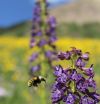(Press-News.org) For almost 40 years, field scientists strapped on cross-country skis, shouldered backpacks with supplies and set out over three miles of snow and rocks to a field station by a meadow high in the Rocky Mountains as soon as the snow began melting. Every other day, they counted each flower they found, identified the plant it belonged to and kept meticulous records of their observations.
Their observations provide the longest-running scientific study of its kind and tell a story of biological change that teaches scientists new lessons about phenology – the timing of biological events – and how they shift under the influence of climate change.
Unlike previous phenological studies that relied mostly on documenting the first appearance of flowers, the new analysis is the first to not only look at when flowers first appear, but also at peak flowering, that is, the time of year when most flowers are blooming, and the last day of flowering in a season. The study was led by Paul CaraDonna, a third-year doctoral student in the Department of Ecology and Evolutionary Biology at the University of Arizona, and Amy Iler, a postdoctoral researcher from the University of Maryland. The results are published this week in the journal Proceedings of the National Academy of Sciences.
The paper paints a much more complex picture than previous phenological studies on which ecologists have relied to gather clues about how climate change affects the timing of biological events like flower buds popping, animals emerging from hibernation, leaves turning in the fall or flocks of birds taking off for their seasonal migration.
"We already knew that the timing of biological events, such as emergence of the first flowers in a season, has been shifting toward earlier dates, but we show it's more complicated than that," said Iler, who is affiliated with the Rocky Mountain Biological Laboratory where the research was carried out.
Analyzing the long-term field records, CaraDonna's team discovered that over the course of 39 years, the flowering season at the study site has expanded by more than a month, driven by earlier snowmelt and warming climate.
"In a high-mountain ecosystem that is hemmed in by snow for most of the year, a whole month is a big deal," said CaraDonna, who is a member in the lab of UA Distinguished Professor Judith Bronstein.
Located at 9,500 feet in Colorado, the study site at the Rocky Mountain Biological Laboratory encompasses meadows with wildflowers, aspen and conifer forests that are covered by a snow pack for the majority of the year. Once the snow melts in mid-May, flowers have only until early October to emerge, bloom, attract pollinators and disperse their seeds before the snow returns.
In many cases of recent studies, researchers relied on data sets collected by others instead of spending time actually looking at the plants and animals in nature, CaraDonna said.
"Because we have spent so much time outside gathering these phenological data, we began to realize that it's not as simple as the first observation. There is a lot more going on," he said.
"Our observations over the entire course of the season allow us to determine the complete distribution of blooming plants over time, and from those distributions we can gather a much deeper ecological insight and better answers to questions that aim to link climate to biological events."
In addition, the study revealed that the degree to which plants flower at the same time changed over the course of the 39 years, potentially representing a shift in interactions among plants.
"Such interactions can be plants competing over nutrients or pollinators," CaraDonna explained. "For example, if plant species A used to flower all by itself, it used to have a monopoly on the pollinator market. But if plant species B now flowers earlier and overlaps with A, they now both compete for the same pollinator. "
Phenological changes, the researchers say, can reshape the various aspects of biological systems across the world and potentially even affect agriculture and the global food supply.
"It's a cascading effect," CaraDonna said. "Climate changes not only how plants interact with each other but how they interact with animals like pollinators and seed eaters, too. Climate change is happening all over the world, and we can expect spillover effects that add up and may very well influence agricultural systems."
Exactly how those changes reshape ecosystems will require more research, according to CaraDonna and his collaborators.
In the meantime, their study provides data that could inform algorithms used in simulations that model phenological change to help predict what the future might have in store.
"We now know that first flowering advances the strongest under warming temperatures; the time of peak flowering a bit less, and the timing of last flowering varies quite a bit," Iler said. "Even if other scientists who are modeling phenological change for other systems may not be able to use our data directly, they can at least make educated decisions on how to weight these factors differently to make those models more realistic."
"We hope our study sets a new standard," she added. "It is exciting to see the National Phenology Network, which is based in Tucson, encourage citizen scientists help collect data, and they are starting to use this kind of information."
INFORMATION:
The paper was co-authored by David W. Inouye of the Rocky Mountain Biological Laboratory and the Department of Biology at the University of Maryland.
The article, Shifts in flowering phenology reshape a subalpine plant community, by Paul J. CaraDonnaa, Amy M. Ilera and David W. Inouye, will be published in PNAS the week of March 17, 2014.
Lessons from a meadow
Presenting some of the most comprehensive information on blooming cycles over the course of four decades reveals that the timing of events within biological communities is more complex than previously thought
2014-03-18
ELSE PRESS RELEASES FROM THIS DATE:
Supplements not associated with reduced risk of cardiovascular disease in elderly
2014-03-18
Bottom Line: Daily dietary supplements of omega-3 polyunsaturated fatty acids (also found in fish) or lutein and zeaxanthin (nutrients found in green leafy vegetables) were not associated with reduced risk for cardiovascular disease (CVD) in elderly patients with the eye disease age-related macular degeneration.
Author: The writing group for the Age-Related Eye Disease Study 2 (AREDS2) clinical trial.
Background: Diet studies have suggested that increased intake of fish, a source of omega (ω)-3 fatty acids, can reduce rates of cardiac death, death from all other ...
Study finds high utilization of neuroimaging for headaches despite guidelines
2014-03-18
Bottom Line: Neuroimaging for headaches is frequently ordered by physicians during outpatient visits, despite guidelines that recommend against such routine procedures.
Author: Brian C. Callaghan, M.D., M.S., of the University of Michigan Health System, Ann Arbor, and colleagues.
Background: Most headaches are due to benign causes, and multiple guidelines have recommended against routine neuroimaging for headaches.
How the Study Was Conducted: The authors analyzed National Ambulatory Medical Care Survey data for all headache visits for patients 18 years or older ...
The frozen truth about glaciers, climate change and our future
2014-03-18
Lewis Owen has been scraping out icy fragments of history's truth from one of the most glaciated regions on Earth for the past 25 years.
His frequent excursions to Tibet and the Himalayas have led the University of Cincinnati professor of geology to some cold, hard facts.
Owen knows climate change is immortal – fluctuating across millennia, patiently building toward moments when circumstances are ripe for apocalypse. It was true thousands of years ago, when rapid climate change had profound effects on landscapes and the creatures that lived on them. That scenario could ...
Rice study: Simple changes to homework improved student learning
2014-03-18
A new study offers evidence that simple and inexpensive changes to existing courses can help students learn more effectively.
The study from Rice University and Duke University found that making a few changes to homework assignments in an upper-level undergraduate engineering course at Rice led to improved scores on exams. The study appears this week in the journal Educational Psychology Review.
The findings by a team from Rice's Center for Digital Learning and Scholarship and Duke's Department of Psychology and Neuroscience demonstrate how technology and cognitive ...
Researchers devise new, stretchable antenna for wearable health monitoring
2014-03-18
Researchers from North Carolina State University have developed a new, stretchable antenna that can be incorporated into wearable technologies, such as health monitoring devices.
"Many researchers – including our lab – have developed prototype sensors for wearable health systems, but there was a clear need to develop antennas that can be easily incorporated into those systems to transmit data from the sensors, so that patients can be monitored or diagnosed," says Dr. Yong Zhu, an associate professor of mechanical and aerospace engineering at NC State and senior author ...
A 'back to the future' approach to taking action on climate change
2014-03-18
How can communities dodge future disasters from Mother Nature before she has dealt the blow? Researchers are taking a unique approach to the issue and gaining input and support from community stakeholders. Daniel Murphy, a University of Cincinnati assistant professor of anthropology, will present findings on March 20, at the 74th annual meeting of the Society for Applied Anthropology (SFAA) in Albuquerque, N.M.
The presentation reveals an innovative, interdisciplinary research technique for approaching climate change vulnerability that's called Multi-scale, Interactive ...
Study finds risk of death among ICU patients with severe sepsis has decreased
2014-03-18
In critically ill patients in Australia and New Zealand with severe sepsis or septic shock, there was a decrease in the risk of death from 2000 to 2012, findings that were accompanied by changes in the patterns of discharge of intensive care unit (ICU) patients to home, rehabilitation, and other hospitals, according to a study appearing in JAMA. The study is being released early to coincide with its presentation at the International Symposium on Intensive Care and Emergency Medicine.
Severe sepsis and septic shock are the biggest cause of death in critically ill patients. ...
Sepsis study comparing 3 treatment methods shows same survival rate
2014-03-18
Survival of patients with septic shock was the same regardless of whether they received treatment based on specific protocols or the usual high-level standard of care, according to a five-year clinical study. The large-scale randomized trial, named ProCESS for Protocolized Care for Early Septic Shock, was done in 31 academic hospital emergency departments across the country and was funded by the National Institute of General Medical Sciences (NIGMS), a component of the National Institutes of Health.
The results of the trial, led by Derek C. Angus, M.D., M.P.H., and Donald ...
North Carolina crack bust highlights need for strong defense
2014-03-18
North Carolina crack bust highlights need for strong defense
Article provided by Barnett & Falls
Visit us at http://www.barnettfalls.com
Catching and prosecuting suspected drug traffickers is a huge priority for both state and federal law enforcement officials in North Carolina. In many cases, drug investigations can persist for weeks or even months before arrests are made. During this time, police work to amass significant evidence from wiretaps, surveillance, undercover officers and sting operations that can be difficult to combat in court.
An illustrative ...
Despite more insurance options, medical debt still a main cause of bankruptcy
2014-03-18
Despite more insurance options, medical debt still a main cause of bankruptcy
Article provided by Law Offices of Scott R. Schneider
Visit us at http://www.scott-schneider.com
Even with the recent implementation of the Patient Protection and Affordable Coverage Act (PPACA, colloquially known as "Obamacare"), it is still expected that medical debt - a leading cause of bankruptcy filings across the country - will still prove unmanageable for tens of thousands of people across the nation this year. Medical expenses have been steadily rising for the past several ...
LAST 30 PRESS RELEASES:
Making lighter work of calculating fluid and heat flow
Normalizing blood sugar can halve heart attack risk
Lowering blood sugar cuts heart attack risk in people with prediabetes
Study links genetic variants to risk of blinding eye disease in premature infants
Non-opioid ‘pain sponge’ therapy halts cartilage degeneration and relieves chronic pain
AI can pick up cultural values by mimicking how kids learn
China’s ecological redlines offer fast track to 30 x 30 global conservation goal
Invisible indoor threats: emerging household contaminants and their growing risks to human health
Adding antibody treatment to chemo boosts outcomes for children with rare cancer
Germline pathogenic variants among women without a history of breast cancer
Tanning beds triple melanoma risk, potentially causing broad DNA damage
Unique bond identified as key to viral infection speed
Indoor tanning makes youthful skin much older on a genetic level
Mouse model sheds new light on the causes and potential solutions to human GI problems linked to muscular dystrophy
The Journal of Nuclear Medicine ahead-of-print tip sheet: December 12, 2025
Smarter tools for peering into the microscopic world
Applications open for funding to conduct research in the Kinsey Institute archives
Global measure underestimates the severity of food insecurity
Child survivors of critical illness are missing out on timely follow up care
Risk-based vs annual breast cancer screening / the WISDOM randomized clinical trial
University of Toronto launches Electric Vehicle Innovation Ontario to accelerate advanced EV technologies and build Canada’s innovation advantage
Early relapse predicts poor outcomes in aggressive blood cancer
American College of Lifestyle Medicine applauds two CMS models aligned with lifestyle medicine practice and reimbursement
Clinical trial finds cannabis use not a barrier to quitting nicotine vaping
Supplemental nutrition assistance program policies and food insecurity
Switching immune cells to “night mode” could limit damage after a heart attack, study suggests
URI-based Global RIghts Project report spotlights continued troubling trends in worldwide inhumane treatment
Neutrophils are less aggressive at night, explaining why nighttime heart attacks cause less damage than daytime events
Menopausal hormone therapy may not pose breast cancer risk for women with BRCA mutations
Mobile health tool may improve quality of life for adolescent and young adult breast cancer survivors
[Press-News.org] Lessons from a meadowPresenting some of the most comprehensive information on blooming cycles over the course of four decades reveals that the timing of events within biological communities is more complex than previously thought




